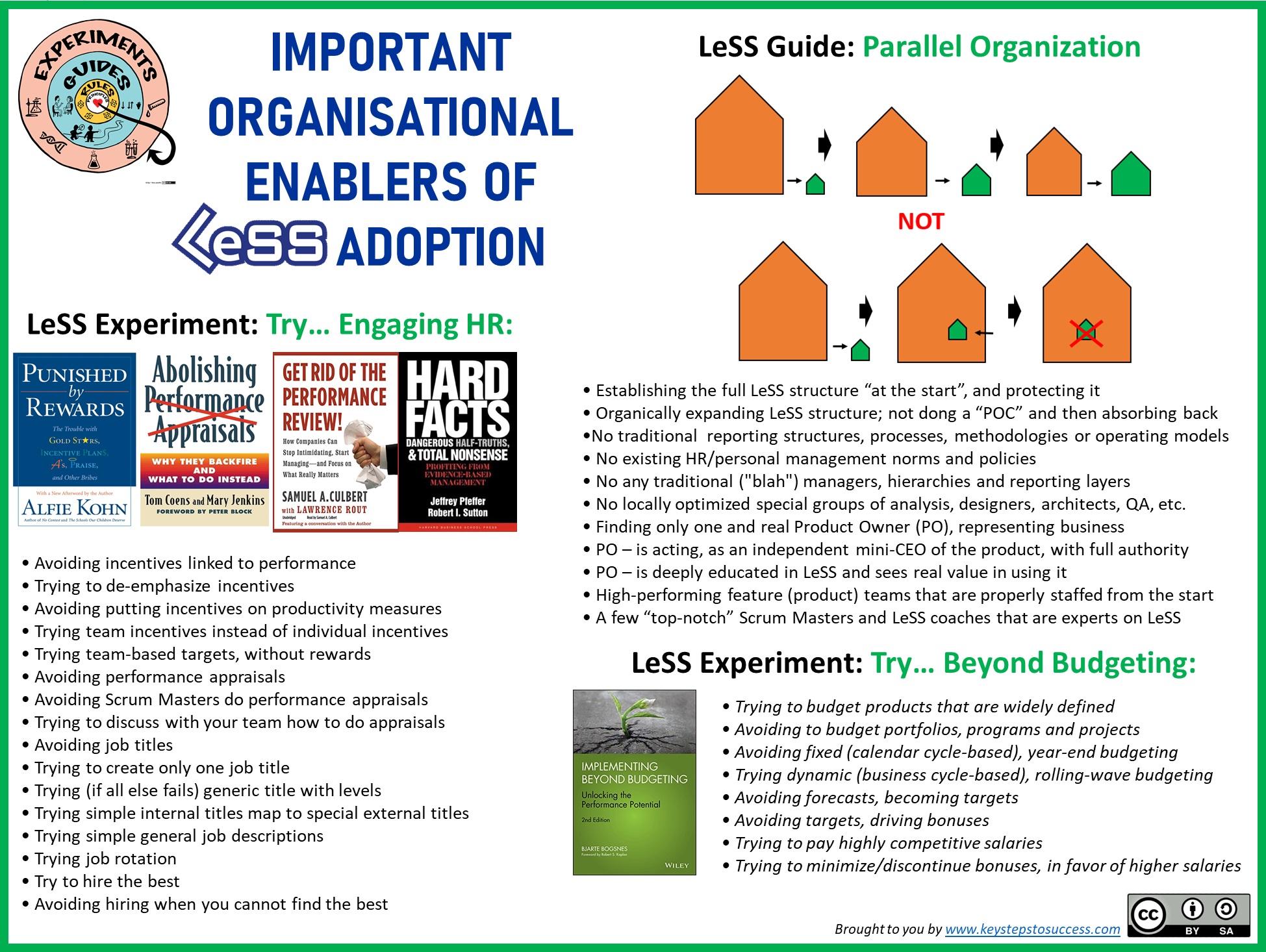In sum, there are ten LeSS Principles, based on which, there are twenty eight LeSS Rules that have been defined. LeSS Guides are discussed in the latest LeSS book: Large-Scale Scrum: More with LeSS (2015) – and their purpose is to provide guidance for LeSS rules’ implementation. Lastly, there are 600+ LeSS Experiments, covered in the earlier LeSS book: Scaling Lean & Agile Development (2009) – and their purpose is to provide some Try/Avoid recommendations during LeSS implementations.
LeSS evolution journey is more than 20 years old. During this time, a lot of learning has been collected and documented, and there are many LeSS adoption case studies that have been published.
After doing another thorough review of the above references, I (Gene) have identified for myself a few super-critical organizational enablers that seem to create a very strong dependency for success of a LeSS adoption. It does not mean that other principles, rules, guidelines and experiments are not important. It just means that what is listed below, has always been the main guarantor of LeSS adoption success, at least, in my (Gene) experience.
These important ORGANIZATIONAL ENABLERS are as follows:
- LeSS Guide: Parallel Organization, explicitly broken down in the LeSS book, as follows:
- Establishing the full LeSS structure “at the start”, and protecting it
- Organically expanding LeSS structure; not dong a “POC” and then absorbing back
- No traditional reporting structures, processes, methodologies or operating models
- No existing HR/personal management norms and policies
- No any traditional (“blah”) managers, hierarchies and reporting layers
- No locally optimized special groups of analysis, designers, architects, QA, etc.
- Finding only one and real Product Owner (PO), representing business
- PO – is acting, as an independent mini-CEO of the product, with full authority
- PO – is deeply educated in LeSS and sees real value in using it
- High-performing feature (product) teams that are properly staffed from the start
- A few “top-notch” Scrum Masters and LeSS coaches that are experts on LeSS
- LeSS Experiment: Try… Engaging HR, explicitly broken down in the LeSS book, as follows:
- Avoiding incentives linked to performance
- Trying to de-emphasize incentives
- Avoiding putting incentives on productivity measures
- Trying team incentives instead of individual incentives
- Trying team-based targets, without rewards
- Avoiding performance appraisals
- Avoiding Scrum Masters do performance appraisals
- Trying to discuss with your team how to do appraisals
- Avoiding job titles
- Trying to create only one job title
- Trying (if all else fails) generic title with levels
- Trying simple internal titles map to special external titles
- Trying simple general job descriptions
- Trying job rotation
- Try to hire the best
- Avoiding hiring when you cannot find the best
- LeSS Experiment: Try… Beyond Budgeting, explicitly broken down by the author of this post:
- Trying to budget products that are widely defined
- Avoiding to budget portfolios, programs and projects
- Avoiding fixed (calendar cycle-based), year-end budgeting
- Trying dynamic (business cycle-based), rolling-wave budgeting
- Avoiding forecasts, becoming targets
- Avoiding targets, driving bonuses
- Trying to pay highly competitive salaries
- Trying to minimize/discontinue bonuses, in favor of higher salaries

